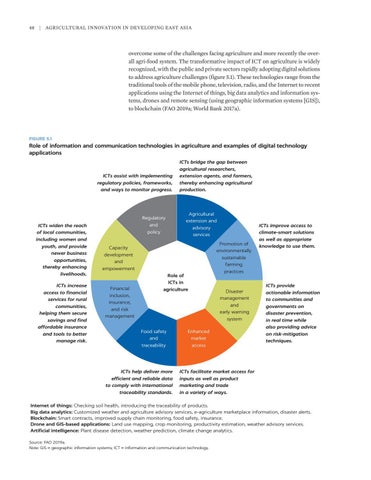48 | Agricultural Innovation in Developing East Asia
overcome some of the challenges facing agriculture and more recently the overall agri-food system. The transformative impact of ICT on agriculture is widely recognized, with the public and private sectors rapidly adopting digital solutions to address agriculture challenges (figure 5.1). These technologies range from the traditional tools of the mobile phone, television, radio, and the Internet to recent applications using the Internet of things, big data analytics and information systems, drones and remote sensing (using geographic information systems [GIS]), to blockchain (FAO 2019a; World Bank 2017a).
FIGURE 5.1
Role of information and communication technologies in agriculture and examples of digital technology applications
ICTs assist with implementing regulatory policies, frameworks, and ways to monitor progress.
ICTs widen the reach of local communities, including women and youth, and provide newer business opportunities, thereby enhancing livelihoods. ICTs increase access to financial services for rural communities, helping them secure savings and find affordable insurance and tools to better manage risk.
Regulatory and policy
ICTs bridge the gap between agricultural researchers, extension agents, and farmers, thereby enhancing agricultural production.
Agricultural extension and advisory services
Capacity development and empowerment
Financial inclusion, insurance, and risk management
Role of ICTs in agriculture
Food safety and traceability
ICTs help deliver more efficient and reliable data to comply with international traceability standards.
Promotion of environmentally sustainable farming practices
Disaster management and early warning system
Enhanced market access
ICTs improve access to climate-smart solutions as well as appropriate knowledge to use them.
ICTs provide actionable information to communities and governments on disaster prevention, in real time while also providing advice on risk-mitigation techniques.
ICTs facilitate market access for inputs as well as product marketing and trade in a variety of ways.
Internet of things: Checking soil health, introducing the traceability of products. Big data analytics: Customized weather and agriculture advisory services, e-agriculture marketplace information, disaster alerts. Blockchain: Smart contracts, improved supply chain monitoring, food safety, insurance. Drone and GIS-based applications: Land use mapping, crop monitoring, productivity estimation, weather advisory services. Artificial intelligence: Plant disease detection, weather prediction, climate change analytics. Source: FAO 2019a. Note: GIS = geographic information systems; ICT = information and communication technology.

